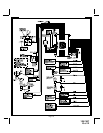
128-7407
9 of 12
terminal 85 & 87 to a fuse + 12 volt source. Connect terminal 30 to the low current door unlock wire from the
factory door switch to the door unlock control relay.
Resistive Circuits, As Well As 4 Wire Polarity Reversal and 5 Wire Alternating 12 Volt
Door Lock Control Circuits
These applications require the use of additional components which may include relays, fixed resistors, or for
convenience, the AS 9159 Door Lock Interface. Refer to the AUDIOVOX Door Lock Wiring Supplement and
or the Audiovox fax back service for information on your particular vehicle for properly connecting to these
types of circuits.
4 Wire Antenna Cable:
If you've not done so already, be certain to connect the Red/Green/Black/Blue 4 wire transceiver cable
assembly to both the antenna assembly, and the mating connector of the control module or your transmit-
ters will not operate.
4 Pin Upgrade Telematic Module:
Red = + 5 Volts / Black = Ground / White = Data TX / Yellow = Data RX
Connect the 4 pin harness found in the Telematic one way module kit to the mating port on the PTUGM.
NOTE: If using the TWO WAY Telematic module, only Ground, TX, and RX are used on this port, the + 12 volt supply
for the two way module must be sourced separately or the unit will not operate.
4 Pin Data Bus Upgrade Module Connector:
The brown 4 pin data bus upgrade module connector located on the side of the module is designed to allow direct
plug in of specific Audiovox upgrade data bus modules which when used will facilitate installation in certain
vehicles.
COMPLETING THE INSTALLATION
NOTE: This unit has the ability to learn the dome light delay time, up to 60 seconds. If the vehicle has
delay interior lights, and you wish to avoid three chirp, defect zone, indication normally associated with
this type of interior light, we suggest you learn the interior light delay.
To learn the light delay, start with all doors closed:
(1) Use the transmitter to Lock / Unlock / Lock / Unlock / Lock / Unlock / Lock, the system.
The LED turns on solid to confirm the system entered the learn mode.
(2) Immediately open and close the door of the vehicle to initiate the dome delay.
The unit will monitor the door trigger input Positive, (Purple), and Negative, (Brown) when active.
When the dome light turns off, the unit will add 2 seconds then exit the learn mode.
(3) The LED will begin flashing the Armed indication indicating the unit has exited the learn mode and is
armed.
Adjusting the Shock Sensor: If used, the sensitivity of the pre - detect circuit is automatically set 30% less
sensitive than the full trigger circuit.
Using a small screwdriver, gently turn the adjustment screw fully counterclockwise. (DO NOT over turn this
screw. Maximum rotation for this adjustment is 270°). Close the hood and trunk lids, and arm the alarm.
Wait 6 seconds for the accessories trigger zone to stabilize, then firmly strike the rear bumper with the side
of a closed fist considering the amount of force required to break a window.
CAUTION: Never perform this test on the vehicle’s glass, as you may break the window.
Turn the adjustment screw clockwise (increasing sensitivity) about ¼ turn and re-test. Repeat this
procedure until the alarm sounds. Ultimately, one firm strike to the rear bumper will cause the alarm to emit
pre-detect warning tones.
WARNING ! Setting the sensitivity too high can cause false alarms due to noise vibrations from passing trucks
and heavy equipment. To decrease sensitivity, turn the adjustment screw counter clockwise.
Wire Dressing: Always wrap the alarm wires in convoluted tubing, or with a spiral wrap of electrical tape.
Secure these looms along the routing using cable ties. This will ensure that the alarm wires are not
damaged by falling onto hot or sharp moving surfaces in the vehicle.
Operation: Take a few moments to check off the appropriate option boxes in the owner’s manual, and to
fully explain the operation of the system to your customer.
Place the Valet Switch Tag and or the Remote Start Control Switch Tag on their respective switches and
point these out to the customer.
Page 9














